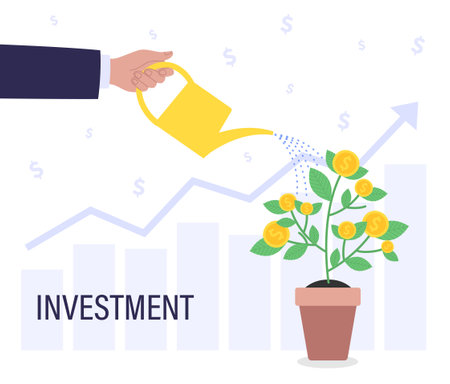1. What is an IPO?
If you’ve ever heard the buzz about a company “going public,” you’re likely hearing about an Initial Public Offering, or IPO. In the American financial world, an IPO marks the moment when a privately-held company offers its shares to the public for the first time on a stock exchange like the NYSE or NASDAQ. But why do companies take this big step? Typically, businesses choose to go public to raise capital that can fuel expansion, pay off debts, or increase their market presence. It’s also a way for early investors and founders to cash out some of their investment. When you hear terms like “filing with the SEC,” “underwriters,” or “lock-up period,” these are all part of the IPO process that help ensure everything is transparent and regulated. Understanding these basics sets the stage for diving deeper into how IPOs work and what they could mean for your investment strategy in the U.S. market.
2. The IPO Process: How Companies Go Public
For a company in the United States, going public through an Initial Public Offering (IPO) is a structured and regulated journey. This process not only opens the doors to new capital but also brings greater visibility and accountability. Let’s walk through the key steps involved in taking a company public, and highlight the crucial roles played by investment banks and regulatory agencies like the Securities and Exchange Commission (SEC).
The Step-by-Step IPO Journey
The IPO process is detailed and involves several stages, each designed to ensure transparency, compliance, and market readiness. Here’s a simplified overview:
| Step | Description |
|---|---|
| 1. Choosing Advisors | The company selects investment banks (underwriters) to guide the IPO, assess value, and help structure the offering. |
| 2. Due Diligence & Filings | Underwriters and company management prepare financial statements and business disclosures, then file a registration statement (S-1) with the SEC. |
| 3. SEC Review | The SEC reviews submitted documents for accuracy and completeness, often requesting clarifications or revisions before approval. |
| 4. Roadshow | Company executives and underwriters present the business to potential investors across the country to generate interest and gauge demand. |
| 5. Pricing | The final share price is set based on investor feedback, market conditions, and company valuation. |
| 6. Going Public | Shares begin trading on a stock exchange (like NYSE or NASDAQ), marking the official transition to a public company. |
The Key Players: Who Does What?
Navigating an IPO requires collaboration between several parties:
- Investment Banks: Serve as underwriters who manage logistics, pricing, marketing, and allocation of shares.
- Company Executives: Work closely with advisors to present their story, complete necessary paperwork, and make strategic decisions.
- The SEC: Acts as the main regulatory body ensuring all disclosures meet legal requirements and protect investors.
A Regulated Pathway for Investor Confidence
This thorough process helps U.S. companies raise capital while giving potential investors a transparent look into business operations and risks—empowering smarter investment decisions. Understanding this pathway can help you better evaluate new opportunities when companies go public.

3. Why Do Companies Decide to Go Public?
When a company decides to go public, it’s often a strategic move with several important goals in mind. Let’s break down the key reasons businesses choose to launch an IPO and what these motivations mean for both the company and potential investors.
Raising Capital for Growth
One of the main drivers for companies to go public is the opportunity to raise significant capital. By selling shares on the stock market, businesses can access funds that may not be available through private channels. This fresh infusion of cash can help companies expand operations, invest in research and development, pay off debt, or even acquire other businesses. For many growing firms, an IPO represents a critical step in scaling up to compete on a national or global stage.
Increasing Visibility and Credibility
Going public also brings heightened visibility and credibility within the business world. Once listed on a major exchange like the NYSE or NASDAQ, a company is subject to greater media attention and increased scrutiny from analysts and investors. This level of transparency can boost consumer confidence, attract new customers, and make it easier to establish partnerships or negotiate better terms with suppliers.
Providing Liquidity for Early Investors
Another important reason for launching an IPO is to provide liquidity for early investors—such as founders, employees, and venture capitalists—who have supported the company since its early days. When shares become publicly traded, these stakeholders finally have an opportunity to sell some of their holdings and realize returns on their investments. This process not only rewards those who believed in the company from the start but also helps attract future talent by offering stock-based compensation with a clear path to liquidity.
Setting the Stage for Future Opportunities
An IPO can open doors to additional opportunities down the road. Publicly traded companies are often better positioned to raise more money through secondary offerings, issue bonds at favorable rates, or use their stock as currency for mergers and acquisitions. In short, going public is not just about raising money now—it’s about unlocking long-term growth potential and staying competitive in a dynamic marketplace.
4. What Does an IPO Mean for Investors?
When a company goes public through an Initial Public Offering (IPO), it opens up new opportunities for individual and institutional investors to become part-owners of the business. But before jumping in, it’s important to understand both the potential benefits and risks that come with investing in IPOs, as well as how shares are typically allocated in the U.S. market.
New Investment Opportunities
An IPO allows regular investors to buy shares of a company that were previously unavailable on public exchanges like the NYSE or Nasdaq. This can be exciting, especially if you believe in the company’s future growth. Some well-known companies—think Google, Facebook, or Uber—made headlines with their IPOs and delivered significant returns for early investors. However, not every IPO tells the same story.
Potential Rewards and Risks
| Potential Rewards | Potential Risks |
|---|---|
| Access to high-growth companies early | Volatile price swings on listing day and beyond |
| Possibility of strong initial returns (“IPO pop”) | Lack of historical performance data |
| Diversification in your investment portfolio | The company may be overvalued at launch |
While there’s a chance to gain from “first-day pops”—when share prices surge above the offering price—IPOs can also be unpredictable. Sometimes, after the initial excitement, prices drop below the original offering price. It’s essential to do your homework: read the company’s prospectus (the S-1 filing) and consider your own risk tolerance before investing.
How IPO Shares Are Allocated in the U.S.
Getting access to IPO shares isn’t always straightforward for everyday investors. Here’s how allocation generally works:
| Investor Type | Allocation Likelihood |
|---|---|
| Institutional Investors (mutual funds, pension funds) | High – Often receive priority allocation due to large orders and existing relationships with underwriters. |
| Retail Investors (individuals) | Low to Moderate – May get access via large brokerage firms, but shares are limited and demand is high. |
| Company Insiders & Employees | Very High – Frequently granted early access through reserved pools. |
If you want a shot at participating in an IPO as a retail investor, you’ll typically need an account with a brokerage firm that participates in IPO allocations—like Fidelity or Charles Schwab—and even then, allocations aren’t guaranteed. Many brokerages require you to meet certain eligibility criteria, such as having a minimum account balance or trading history.
Your Next Steps as an Investor
If you’re interested in investing in an IPO, start by researching upcoming offerings and reviewing their prospectuses carefully. Consider consulting with a financial advisor to determine whether an IPO fits your overall investment strategy. Remember: while IPOs can offer exciting opportunities, they also carry unique risks compared to established stocks.
5. Common Risks and Considerations with IPO Investing
Investing in IPOs can be exciting, but it’s important to remember that buying shares of a newly public company comes with unique risks. Let’s review some of the most significant factors you should keep in mind before jumping in.
Volatility: Expect Price Swings
One of the defining characteristics of IPO stocks is their volatility. In the first days or weeks after an IPO, share prices can swing wildly as the market tries to find a fair value. This happens because there’s often limited historical data for investors to analyze, so speculation and hype can drive prices up—or down—very quickly. If you’re considering investing, ask yourself whether you’re comfortable with potentially sharp price movements and short-term losses.
Lock-Up Periods: Limited Early Selling
Another aspect to consider is the lock-up period, which is a set amount of time (usually 90 to 180 days) after the IPO during which insiders—like company executives and early investors—are restricted from selling their shares. Once this period ends, a sudden increase in available shares can put downward pressure on the stock price as insiders cash out. Smart investors keep an eye on when lock-up periods expire, as this can help predict possible price drops.
Unpredictable Early Performance
The early performance of IPO stocks is notoriously difficult to predict. Some companies soar after going public, while others quickly fall below their offering price. Market sentiment, media coverage, and broader economic conditions all play a role in these early movements. It’s helpful to research comparable companies that have recently gone public to get a sense of potential outcomes—but remember, past performance isn’t always a reliable guide.
Tips for Making Informed Decisions
- Do Your Homework: Read the company’s prospectus (S-1 filing) carefully and understand its business model, financial health, and growth prospects.
- Avoid FOMO: Don’t let fear of missing out drive your decisions. Take your time to evaluate whether the investment fits your goals and risk tolerance.
- Diversify: Avoid putting too much of your portfolio into one IPO stock. Spreading your investments helps manage risk.
Bottom Line
IPOs offer unique opportunities but also come with real risks. By understanding volatility, lock-up periods, and unpredictable performance—and by making informed decisions—you can better position yourself for long-term success in the world of IPO investing.
6. Practical Steps: How Individual Investors Can Participate
If you’re intrigued by the buzz around IPOs and wondering how to get involved, you’re not alone. Many everyday investors are curious about accessing newly public companies, but it’s important to approach IPO investing thoughtfully. Here’s a step-by-step guide tailored to U.S. investors, along with key considerations for fitting IPOs into your broader financial plan.
Accessing IPOs Through Your Brokerage Account
Most retail investors can participate in IPOs through online brokerage accounts. Major U.S. platforms like Fidelity, Charles Schwab, and TD Ameritrade occasionally offer access to select IPOs for eligible clients. However, availability is often limited and typically requires meeting certain criteria—such as maintaining a minimum account balance or being an active trader. Check with your broker to see if they have an IPO center or eligibility requirements, and be prepared to submit an “indication of interest” if you want a chance at shares.
Understand the Allocation Process
Even if you qualify, receiving shares isn’t guaranteed. Brokers allocate IPO shares based on demand, account history, and sometimes even a lottery system. It’s common for high-demand offerings to be oversubscribed, meaning not everyone gets shares—or only receives a portion of what they requested.
Key Considerations Before Investing in IPOs
Before jumping in, ask yourself whether participating in an IPO aligns with your risk tolerance and long-term goals. IPO stocks can be volatile in their early days as the market determines their value. Be sure to review the company’s prospectus (the S-1 filing) for financial details and risks before investing.
Fit IPOs Into Your Overall Financial Plan
Think of IPO investing as just one part of your broader investment strategy—not a shortcut to quick riches. Diversification is key; avoid putting too much of your portfolio into any single stock, especially one that’s just hit the market. If you’re unsure where IPOs fit within your personal plan, consider speaking with a trusted financial advisor who understands both the opportunities and the risks involved.
By understanding how to access IPOs and weighing whether they make sense for your situation, you’ll be better positioned to make informed choices that support your financial future.


